MAIN MENU
Diamond Doves
Site Map
Diamond doves
Acquiring Diamond Doves
Caring for Diamonds
Living With Diamonds
Raising Diamonds
Growth of a Diamond Baby
One Year's Reproduction Data
Tribute to China
Other Dove Species
Other Geopelia SpeciesRingneck Doves
Eurasian Collared Doves
Cape Doves
Mourning Doves
Mourning Dove Baby Growth
Rock doves
North American Doves
Dove Genera of the World
All Doves
Caring for Injured or Sick DovesTaming Doves
Other
Books of Interest
Some Bird stories
About Me
Links
Informational Sites
American Dove AssociationCommercial Sites
Jeff Dowining - Diamond DovesGarrie Landry - Diamond Doves
Wade Oliver - The Dove Page
Doveland Press - Diamond Doves
Growth of a Diamond Dove Baby
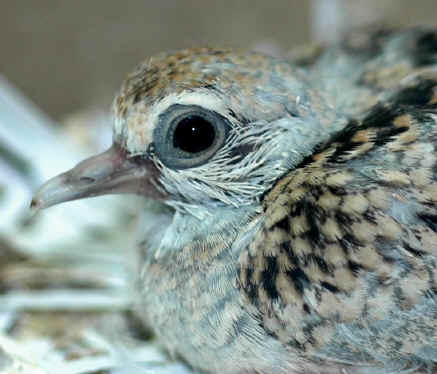
Baby June
Age
10 days
Hatched June 24, 2007
Baby Development
Many visitors to this site have asked questions about the growth and development of young babies. This section now includes daily
photographs and length measurements of a diamond dove baby for the first three weeks of it's life.
Background of Parents
The male, Australia, was purchased from a breeder in New Mexico and was received in February 2006. He was banded and was two
years old when received. The male was purchased as a caretaker bird for China a
very old hen who had lost her mate and her two best friends, but China died two weeks before the male arrived.
(See the page A Tribute to China). The male lived without a cage for a year and a half and roosted on some oak branches located near the bird cages. He always
picked the same spot allowing his stools to fall on sheet plastic purchased to protect the furniture. He obtained his food and water
by going in open cages.
Tasmania was purchased as a mate for Australia in December 2006. Although Tasmania was interested in Australia from the start,
she was rejected by him as an intruder. After a few months passed then Australia did become interested in her but by then she had
become angry with him and resisted his advances. In February 2007 a cage became free when the white Eurasian collared dove left
for another home and Tasmania moved into the cage and took over the empty nest immediately. She laid her first two infertile eggs
soon after she had the nest. Australia was put in the cage after a week but they fought so he was removed. Several trials were
attempted and then one day we saw Tasmania shake her wings when Australia passed by on the outside. The cage was opened,
he went in and a sometimes violent courtship followed. After some time Tasmania laid two eggs and they incubated them. Both
eggs were fertile but the embryos died just before the end of the incubation period. After some time a second clutch was laid and
and this page is the story of the second baby in that clutch. He hatched out on June 24, 2007.
Growth Records
The graph below displays the daily growth records from age 0 to age 21 days which is about the time most babies are allowed to stay in the parent's cage
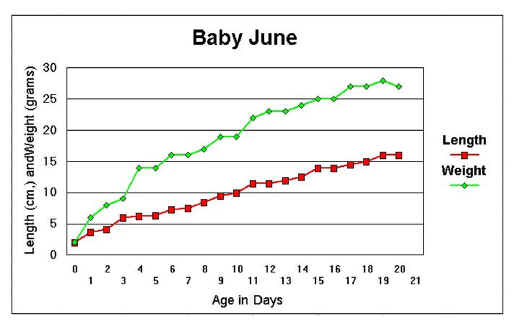
Do note the change in size of the baby is not well
represented in the photos as the photos at the younger ages were taken closer to the
dove than those taken at the older ages. This procedure provided a greater amount of detail in the younger bird. However the length
of the baby is given for each day
| Day 1 | June 24, 2007 The first baby of this clutch was too weak to feed and tossed form the nest. The second baby hatched out on the morning of July 24, 2007. The parents kept it covered except for feeding. |
|
| Day 2 | June 25, 2007 The parents kept the baby covered except for feeding. |
|
| Day 3
|
June 26, 2007 The baby sometimes opened its eyes. The parents again keep the baby covered except for feeding. Length: 4.1 centimeters (est.) Weight: 8 grams (est.) |
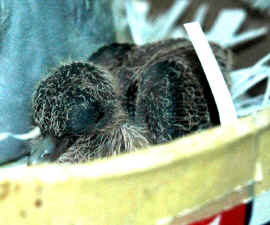 |
| Day 4 | June 27, 2007 The babies eyes are now open except when sleeping after being fed. Pin feathers can be seen over most of the body Length: 6.0 centimeters. Weight: 9 grams |
 |
| Day 5 | June 28, 2007 The pin feathers have grown longer and the feather vanes can bow be seen at the end of the pin feathers. Length: 6.2 centimeters. Weight:14 grams |
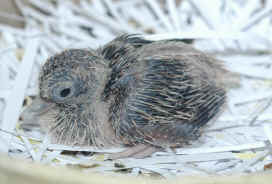 |
| Day 6 | June 29, 2007 Most of the wing feather vanes can now be seen, but the head is still covered with pinfeathers. The dark colored primary flight feathers are now visible. The tail feathers are just starting to grow out. Length: 6.4 centimeters. Weight: 14 grams |
 |
| Day 7 | June 30, 2007 The baby is left uncovered all the time. He is fairly inactive and sleeps after being fed. Does not beg for food. Length: 7.3 centimeters Weight: 16 grams |
 |
| Day 8 | July 1, 2007 The baby now has some fully opened feathers on his head. He is now very active and is walking around the nest, sometimes looking over the edge. Preens his own feathers for the first time. Length: 7.5 centimeters Weight: 16 grams |
 |
| Day 9 | July 2, 2007 The baby continues to be active and often begs for food. The tails has extended the bird's length another centimeter . Length: 8.5 centimeters Weight: 17 grams |
 |
| Day 10 | July 3, 2007 Frequently begs for food. Continues to be very active. Length: 9.5 centimeters Weight: 19 grams |
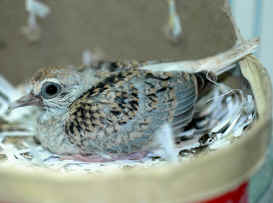 |
| Day 11 | July 4, 2007 Took out of nest to measure and put on carpet. The baby flew up about three feet and then across the room to the couch. Length: 10 centimeters Weight: 19 grams |
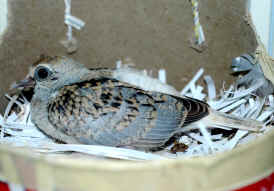 |
| Day 12 | July 5, 2007
Now flies around cage, chasing parents to ask for food. There is some pecking of
seed on the cage floor but does not eat any. |
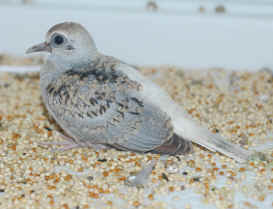 |
| Day 13 | July 6, 2007 Roosted on bar last night with parents. Continues to peck at seed but does not eat any, continues to chase parents for food. Length: 11.5 centimeters Weight: 23 grams |
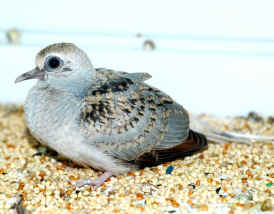 |
| Day 14 | July 7, 2007 Allowed to go to the sun window with the other birds. They taught the baby how to peck bread. Then soon he was able to peck some seed. Made its first peeps. Length: 12 centimeters Weight: 23 grams |
 |
| Day 15 | July 8, 2007 Continued to try and peck seed, mother preened the baby, slept with parents on the perch at night. Length: 12.5 centimeters Weight: 24 grams |
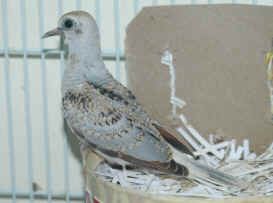 |
| Day 16 |
July 9, 2007 Pecking bread and cheese, trying to peck seed, starting to have success, roosted on perch with both parents at night. Length: 14 centimeters Weight: 25 grams |
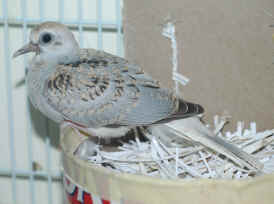 |
| Day 17 |
July 10, 2007 The female laid her first egg of the next clutch late the previous evening. Baby now helps with the incubation of the new egg. Sometimes the baby is left alone with the egg. Length: 14 centimeters Weight 25 grams |
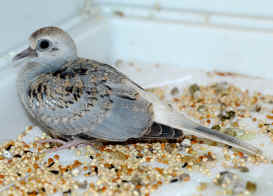 |
| Day 18 |
July 11, 2007 Now able to peck seeds very well. Often sits on the egg with the mother. Length: 14.5 centimeters Weight: 27 grams |
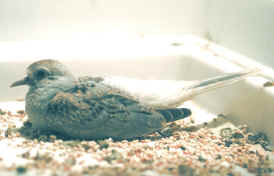 |
| Day 19 |
July 12, 2007 The second egg was laid in the afternoon. Baby helps with incubation but slept with the father on the perch. Length: 15 centimeters Weight: 27 grams |
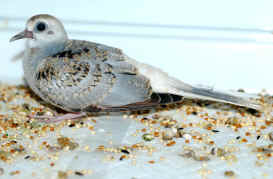 |
| Day 20 |
July 13. 2007 |
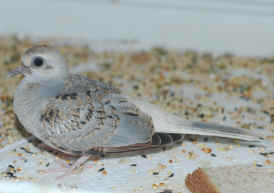 |
| Day 21 | July 14, 2007 No change. Sleeps on perch with father and helps with egg incubation Length: 16 centimeters Weight: 27 grams (note decrease) |
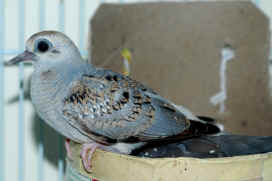 |
Source:
Van Hoozier, Charlotte Cox, M.D. Diamond Doves: A Year
in the Life of My Diamonds, Abe and Sarah. P. O. Box 7043, Macon, GA
31209-7043: Doveland Press, 2001, pp. 130
©2007 - Helen White Helen White
P. O. Box 367,
Tallahassee, FL 32302-0367
Last revised on: November 20, 2007